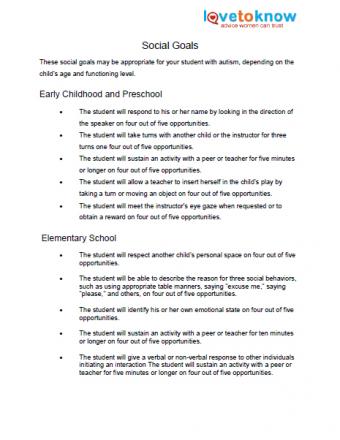
Setting clear, measurable goals is essential for helping a child with autism make progress in and out of the classroom. The child's individualized education plan (IEP) consists of several goals for various areas of challenge for the child. When it is time for your student's IEP meeting, you can bring your own goals to incorporate in the plan.
Bringing Goals to Your Child's IEP Meeting
Your school district will have a meeting once a year to form the details of the child's autism IEP, and whether you're a parent or a teacher, you'll be encouraged to attend this meeting. At the meeting, you'll hear about the child's progress on last year's goals, and you'll have a chance to offer any goals you'd like to see added to the next year's IEP.
When deciding on goals, it's important that they meet these criteria:
- Measurable: The school district needs to document proof of the child's progress, so it's important that the goals are something they can measure.
- Specific: General goals are too hard to document, and it's easy for them to get overlooked. The best IEP goals are very specific.
- Applicable: The goals in the child's IEP must apply to your student, not to autistic children in general.
Example IEP Goals for Students with Autism
If your student has a medical diagnosis or educational label of autism, chances are good that he or she deals with challenges in the areas of communication, social skills, and behavior. Additionally, many children with autism also struggle with fine motor skills and sensory issues, which are usually addressed with the help of an occupational therapist. Be sure to include all of these areas when you make a list of goals for your student with autism.
Communication-Related IEP Goals for Autism

Typically, a speech therapist will help your child achieve communication goals. The goals in this printable are divided by the student's age or grade level. Many children with autism have "splintered" communication skills, which means they may excel at some areas of language, such as vocabulary, while being very delayed in other areas, like non-verbal communication.
When choosing communication goals, consider where your child typically has trouble with language. Some common problem areas include the following:
- Requesting help
- Asking for food, a bathroom break, or another necessary item
- Using language to interact with peers
- Using and understanding gestures
- Understanding facial expressions
The speech therapist will have many great ideas to help, and these goals are simply a good place to start.
Social Skills IEP Goals for Autism

Social skills are an area of challenge for most students with autism. From initiating an interaction with peers to understanding the finer points of body language, your child may struggle to navigate the social world. Choosing developmentally-appropriate goals can make all the difference.
Typically, your child's special education teacher will help your child learn these social goals. You can talk to the teacher before the IEP meeting to find out where your child is running into trouble. You may also have noticed atypical social behavior in your child when you are out in the community. Choose goals that address the issues you have noticed, which might include the following:
- Starting an interaction
- Staying involved in an interaction
- Respecting personal space
- Understanding the feelings and perspectives of others
Behavior IEP Goals for Autism

Students with autism often struggle with repetitive behaviors, stim behaviors, attending to the teacher, and acting out when frustrated. If these behaviors interfere with your child's ability to function in the school, his or her IEP may include some behavioral goals.
You may also have noticed some habits that make life harder for your child. If you're a parent, consult the classroom teacher or special education teacher for more information on how to handle these behaviors at home. Bring a list of specific behaviors to the IEP meeting, as well as some goals you'd like to see for your child, which might include the following:
- Handling frustrations without melting down
- Respecting boundaries
- "Tuning in" or listening to instructions
- Hand flapping, rocking, or spinning
Occupational Therapy IEP Goals for Autism

If your student is on the autism spectrum, he or she may also work with an occupational therapist (OT) of occupational therapy assistant through the school district. Your child's OT will focus on fine motor skills, such as the following:
- Handwriting
- Tying shoes
- Using scissors
- Buttoning or zipping clothing
- Drawing shapes
Many students with autism are also over- or under-sensitive to common stimuli. The lights in the classroom may be too bright for your child or there may be too much noise. Perhaps your child craves spinning or running into things. The OT will work to make sure these sensory needs are met in practical ways within the classroom, allowing your child to focus on learning.
If you need help downloading the printables, check out these helpful tips.
Understanding Parents' Role in Developing Goals
If you're a parent of a child with autism, it's important to remember that no one knows your child as well as you do. You have a very important role when it comes to developing IEP goals. Take some time before the IEP meeting to make a list of areas where you feel your child needs help. Then peruse the printable IEP goals listed here, and select some goals for your child. Your child's education team may have suggestions for modifying these goals as well, and it's important to listen to their professional perspectives. Ultimately, the goals your choose will be a mix of your own goals and those of the education team.







